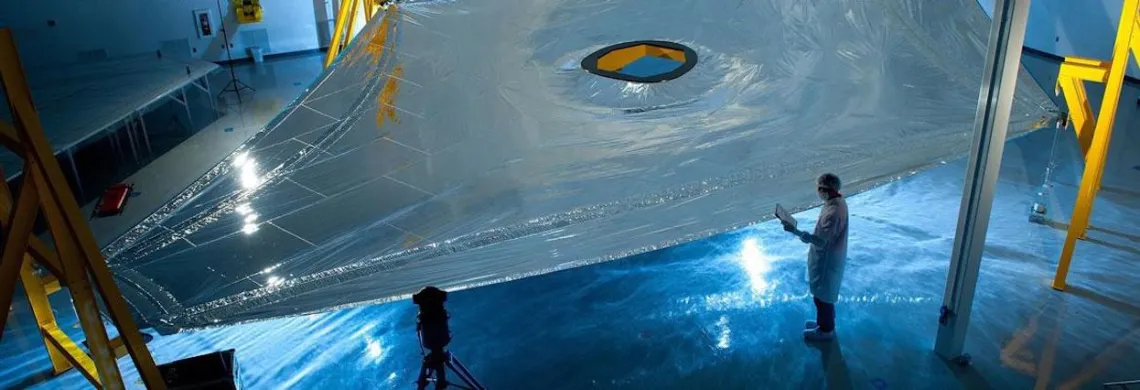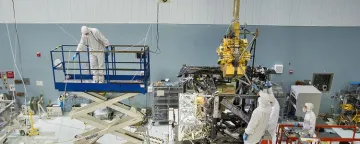James Webb Space Telescope Facts

NASA’s James Webb Space Telescope, scheduled to launch March 2021, will be the largest observatory ever sent into orbit, representing the next generation of giant space telescopes.
In order to peer deeper into space and time than any telescope has before, the JWST relies on cutting-edge optical science and engineering, some of which the University of Arizona has developed.
Facts
- The mirror on James Webb Space Telescope will be made of beryllium, which is lightweight yet strong, and can withstand very cold temperatures. The JWST has to be kept at about -375 degrees Fahrenheit for its instruments to function properly.
- The JWST’s mirror is covered in a thin layer of gold, because gold improves the mirror’s reflection of infrared light. Because the gold is pure and soft, it will be shielded by a protective layer of glass.
- The sunshield on James Webb Space Telescope is 70 feet by 48 feet, or roughly the size of a tennis court.
- All in all, the JWST will weigh 14,000 pounds, which is about as much as a full-size school bus.
- From Earth, the JWST will appear more than 10,000 times fainter than the faintest star seen by the naked eye.
- The JWST will orbit the sun, 940,000 miles away from Earth, four times further away than the moon.
- To fit on the rocket within its six-and-a-half-ton weight limit, yet maintain the size necessary to perform its observations, the JWST telescope was designed to be lightweight and have a flexible structure. This flexibility makes the telescope susceptible to vibrations whenever it moves, even the tiny movements that keep it pointed.
- Just as a shaky camera makes for blurry photos, even small tremors interfere with the telescope’s image quality. To keep images in sharp focus, the JWST needs to minimize vibrations.
- To do this, rubber shock absorbers cushion the tower that holds the primary mirror.

The UA’s Role
The instrument that will form the heart of NASA's JWST was assembled and tested by aerospace company Lockheed Martin under a contract from the University of Arizona.
The Near Infrared Camera instrument, dubbed NIRCam, was designed by Lockheed Martin and the UA, incorporating innovative optical, mechanical, structural, thermal and electronic mechanisms.
NIRCam’s focal plane, which is similar to a digital camera’s imaging sensor, was developed by a team led by Marcia Rieke, a Regents' Professor of Astronomy in the UA’s Steward Observatory.
With its 21-foot mirror, JWST will enable observation of the most distant galaxies. The NIRCam design is optimized for finding first light sources, peering through clouds of hydrogen and dust in space that obscure these objects.
The camera is equipped with coronagraphs, instruments that allow astronomers to take pictures of very faint objects around a central bright object, like planets around distant stars. The NIRCam coronagraphs work by blocking a brighter object's light, making it possible to view the dimmer object nearby – just like shielding the sun from your eyes with an upraised hand can allow you to focus on the view in front of you. With the coronagraphs, astronomers hope to determine the characteristics of planets orbiting nearby stars.
The NIRCam instrument consists of two identical optical imaging modules and contains focal plane assemblies, or FPA, assembled at the UA using detectors provided by Teledyne. The FPA hardware consists of 40 million pixels and is designed for operation in the cold of deep space at 35 degrees Kelvin or about -400 degrees Fahrenheit.
In addition to NIRCam, a mid-infrared-wavelength camera is also part of the telescope’s instrumentation. That instrument was developed by a group led by George Rieke, also a Regents’ Professor at the UA Steward Observatory.

